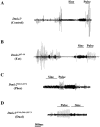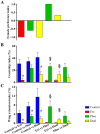Mutations of the Drosophila myosin regulatory light chain affect courtship song and reduce reproductive success
- PMID: 24587213
- PMCID: PMC3935995
- DOI: 10.1371/journal.pone.0090077
Mutations of the Drosophila myosin regulatory light chain affect courtship song and reduce reproductive success
Abstract
The Drosophila indirect flight muscles (IFM) rely on an enhanced stretch-activation response to generate high power output for flight. The IFM is neurally activated during the male courtship song, but its role, if any, in generating the small amplitude wing vibrations that produce the song is not known. Here, we examined the courtship song properties and mating behavior of three mutant strains of the myosin regulatory light chain (DMLC2) that are known to affect IFM contractile properties and impair flight: (i) Dmlc2(Δ2-46) (Ext), an N-terminal extension truncation; (ii) Dmlc2(S66A,S67A) (Phos), a disruption of two MLC kinase phosphorylation sites; and (iii) Dmlc2(Δ2-46;S66A,S67A) (Dual), expressing both mutations. Our results show that the Dmlc2 gene is pleiotropic and that mutations that have a profound effect on flight mechanics (Phos and Dual) have minimal effects on courtship song. None of the mutations affect interpulse interval (IPI), a determinant of species-specific song, and intrapulse frequency (IPF) compared to Control (Dmlc2 (+) rescued null strain). However, abnormalities in the sine song (increased frequency) and the pulse song (increased cycles per pulse and pulse length) evident in Ext males are not apparent in Dual males suggesting that Ext and Phos interact differently in song and flight mechanics, given their known additive effect on the latter. All three mutant males produce a less vigorous pulse song and exhibit impaired mating behavior compared to Control males. As a result, females are less receptive to Ext, Phos, and Dual males when a Control male is present. These results open the possibility that DMLC2, and perhaps contractile protein genes in general, are partly under sexual selection. That mutations in DMLC2 manifest differently in song and flight suggest that this protein fulfills different roles in song and flight and that stretch activation plays a smaller role in song production than in flight.
Conflict of interest statement
Figures





Similar articles
-
The effect of removing the N-terminal extension of the Drosophila myosin regulatory light chain upon flight ability and the contractile dynamics of indirect flight muscle.Biophys J. 2000 Mar;78(3):1431-40. doi: 10.1016/S0006-3495(00)76696-3. Biophys J. 2000. PMID: 10692328 Free PMC article.
-
Courtship song analysis of Drosophila muscle mutants.Methods. 2012 Jan;56(1):87-94. doi: 10.1016/j.ymeth.2011.09.007. Epub 2011 Sep 16. Methods. 2012. PMID: 21945578 Review.
-
Phosphorylation and the N-terminal extension of the regulatory light chain help orient and align the myosin heads in Drosophila flight muscle.J Struct Biol. 2009 Nov;168(2):240-9. doi: 10.1016/j.jsb.2009.07.020. Epub 2009 Jul 25. J Struct Biol. 2009. PMID: 19635572 Free PMC article.
-
Regulatory light chain phosphorylation and N-terminal extension increase cross-bridge binding and power output in Drosophila at in vivo myofilament lattice spacing.Biophys J. 2011 Apr 6;100(7):1737-46. doi: 10.1016/j.bpj.2011.02.028. Biophys J. 2011. PMID: 21463587 Free PMC article.
-
Evolution of Reproductive Behavior.Genetics. 2020 Jan;214(1):49-73. doi: 10.1534/genetics.119.302263. Genetics. 2020. PMID: 31907301 Free PMC article. Review.
Cited by
-
Flightin maintains myofilament lattice organization required for optimal flight power and courtship song quality in Drosophila.Proc Biol Sci. 2017 May 17;284(1854):20170431. doi: 10.1098/rspb.2017.0431. Proc Biol Sci. 2017. PMID: 28469022 Free PMC article.
-
Sensorimotor Transformations Underlying Variability in Song Intensity during Drosophila Courtship.Neuron. 2016 Feb 3;89(3):629-44. doi: 10.1016/j.neuron.2015.12.035. Neuron. 2016. PMID: 26844835 Free PMC article.
-
Life without double-headed non-muscle myosin II motor proteins.Front Chem. 2014 Jul 7;2:45. doi: 10.3389/fchem.2014.00045. eCollection 2014. Front Chem. 2014. PMID: 25072053 Free PMC article. Review.
-
Intrinsic disorder and multiple phosphorylations constrain the evolution of the flightin N-terminal region.J Proteomics. 2016 Mar 1;135:191-200. doi: 10.1016/j.jprot.2015.12.006. Epub 2015 Dec 9. J Proteomics. 2016. PMID: 26691840 Free PMC article.
-
The Contributions of the Amino and Carboxy Terminal Domains of Flightin to the Biomechanical Properties of Drosophila Flight Muscle Thick Filaments.Biology (Basel). 2016 Apr 27;5(2):16. doi: 10.3390/biology5020016. Biology (Basel). 2016. PMID: 27128952 Free PMC article.
References
-
- Brodsky AK (1994) The evolution of insect flight. Oxford Univ Press: 248.
-
- Dudley R (2000) The evolutionary physiology of animal flight: paleobiological and present perspectives. Annu Rev Physiol 62: 135–155. - PubMed
-
- Greenfield MHD (1994) Cooperation and conflict in the evolution of signal interactions. Annu Rev Ecol Syst 25: 97–126.
-
- Ryna MJ, Rand AS (1993) Species recognition and sexual selection as a unitary problem in animal communication. Evolution 47: 647–657. - PubMed
-
- Gerhardt HC (1994) The evolution of vocalization in frogs and toads. Annu Rev Ecol Syst 25: 293–324.
Publication types
MeSH terms
Substances
LinkOut - more resources
Full Text Sources
Other Literature Sources
Molecular Biology Databases
Research Materials

